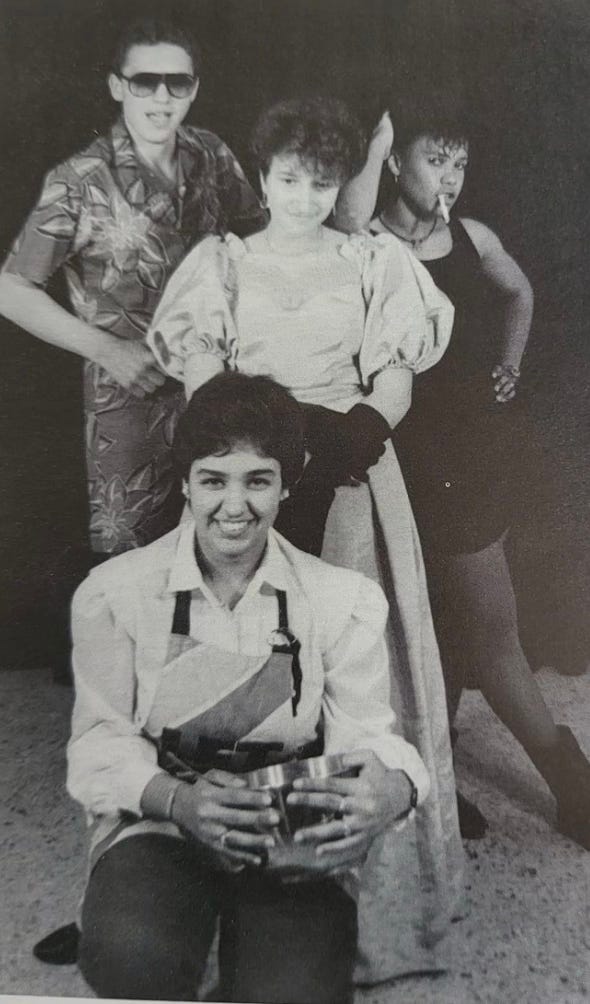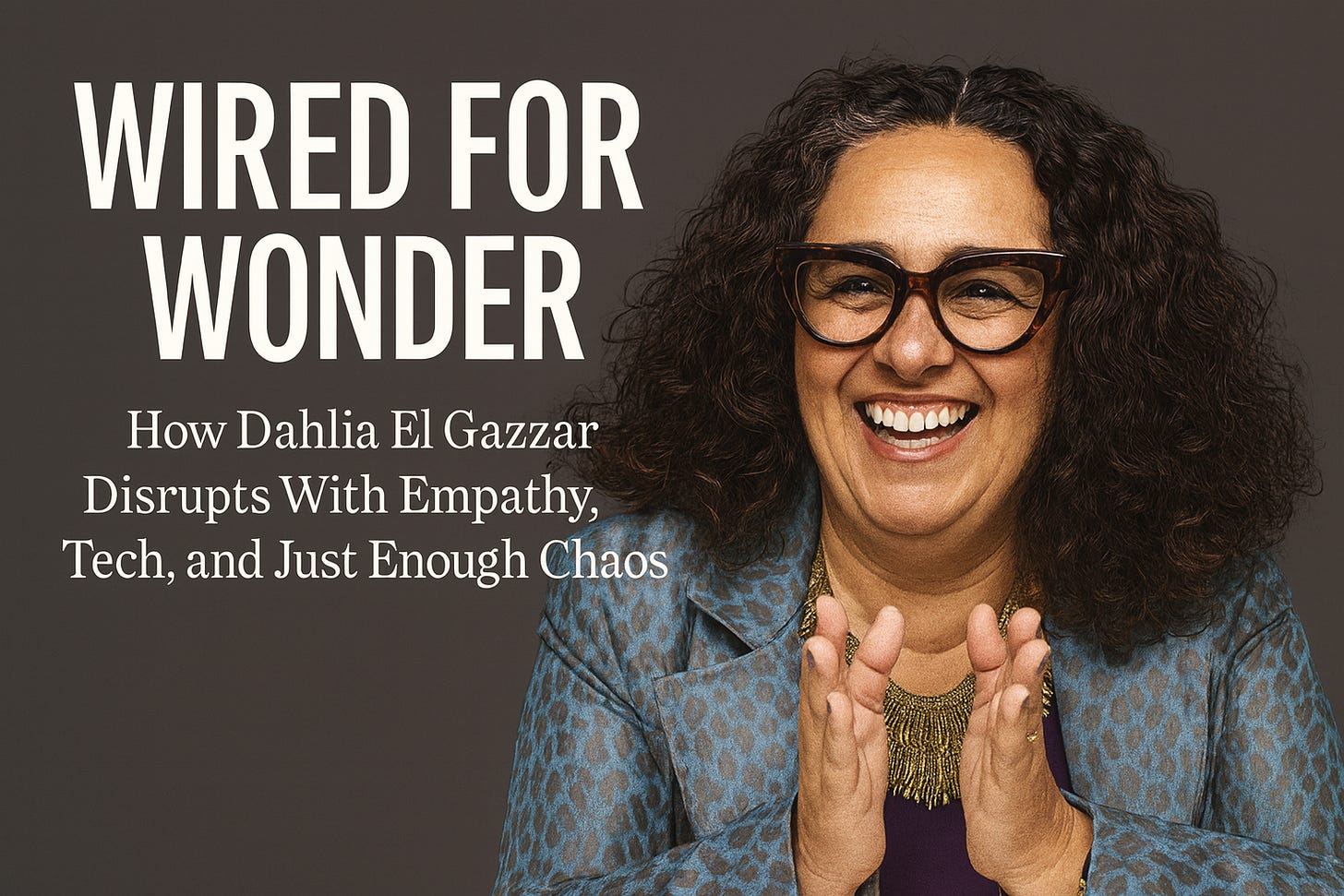Wired for Wonder: Dahlia El Gazzar and the Gospel of Curiosity
From moonlit camel races to AI workflows, Dahlia El Gazzar has built her brand on curiosity, emotional precision, and the courage to disrupt softly.
Every time I talk to Dahlia El Gazzar, I learn something new. Not in a surface-level tech demo kind of way, but in a slow-burn, rearrange-your-brain way. One of the most enduring moments happened curbside in New York over a $25 hot dog. We were talking about relevance—who it’s for, who it slips away from, and how you hold onto it—and she dropped a single word: Perennials.
She didn’t say Gen Z. She didn’t say Millennials. She said Perennials. The endlessly curious. The people who keep blooming, year after year, no matter what trends come and go. That word hit like a thesis. It’s been echoing ever since.
I sat with it while writing this piece—trying to make sense of what ties Dahlia’s story together. She’s done the camel races. She’s run the tech gauntlet. She’s counseled the doubters, sparred with the visionaries, and outlasted half the platforms we used to call the future. And what I landed on is this:
Dahlia isn’t just a strategist. She’s not a futurist. She is the High Priestess of Curiosity and Emotional Disruption.
She doesn’t build the altar. She shakes the room, lights the fire, and makes people feel again.
Her story starts, fittingly, in Egypt. As a child, she was decoding hieroglyphics in second grade—not as part of a tourism packet, but because her teachers believed knowledge didn’t live inside textbooks. “Everything wasn’t in the pages,” she told me. “It was in people, in stories, in streets.” She was educated in a swirl of international classmates and color-coded learning tribes—her class had names like “Blue Giraffes.” She still remembers the feeling of sitting cross-legged in a circle, trying to convince the skeptics that maybe, just maybe, there could be such a thing as a blue giraffe.
That tension—the dreamer facing the naysayer—has become the stage she works from to this day.

In high school, Dahlia was elected president of her class—and her vice president? None other than Hervé Sedky, who would go on to become CEO of Emerald. Their yearbook may not have predicted it, but that pairing turned out to be prophetic: two natural organizers, future industry leaders, learning how to lead side-by-side before either of them knew the stakes. It was an early preview of her talent for leadership, facilitation, and vision. The girl who once rallied classmates around imaginary giraffes now rallied them around real ideas—and it stuck.

After college, she landed a job at a Red Sea resort. The GM gave her a single mandate: “Make people happy. And make money.” So she stole mattress pads off pool loungers, trucked them into the desert under a full moon, and charged tourists $500 a night to sleep under the stars. When diving tours were canceled on New Year’s Day, she negotiated with Bedouins to host a camel race instead. No permits. No deck. No “event bible.” Just intuition, empathy, and storytelling.
That, it turns out, was the prototype. Long before anyone used terms like “experience architect,” Dahlia was building joy out of necessity—and monetizing it through instinct.
Her journey took her from Egypt to Puma to Passkey to OnPeak, where she became the tech world’s translator-in-chief.
Her stint at Puma—landed on a dare—thrust her into the deep end of global marketing and event production. It was exciting, but exhausting. The pace didn’t match the life she wanted to build. She handed in her resignation just before the Sydney Olympics.
At Passkey and OnPeak, Dahlia found her lane. These weren’t jobs, they were turning points. While others pushed product, Dahlia translated need. She stepped into the silences that came with clunky systems and indecipherable UX. She saw friction as a design flaw, not a client issue. And she turned tech into something human again. Her job wasn’t to pitch software. It was to protect the vision—and the people holding it.. It was to protect the vision—and the people holding it.
You can draw a straight line from the dunes to the main stage of IMEX. Her ethos never changed, only the canvas. She still walks into rooms that are stuck and asks, “Why this way?” She still builds systems around emotional logic, not mechanical efficiency. And she still treats curiosity like a full-body sport.
Ask her about her prep process for an event—of which she attends and advises on dozens a year—and she won’t start with topic or slides. She’ll start with emotional climate. “I scan the room before I scan the agenda,” she says. “Where are the blockers? What’s the real fear under the surface?” She doesn’t write speeches; she codes vibes.
She once described a college orientation at Ole Miss as a masterclass in experience design. Not because of a killer app or clever format, but because the university opened with stories. Twenty-five students sharing why they chose the school. Parents weeping in the audience. A chant, a creed, a moment of belonging.
“We start too many conferences in the dark with 5,000 people checking email,” she said. “What if we started with emotional permission to be part of something?”
It’s a question I keep thinking about.
Like all great advisors, Dahlia is also a bit of a contrarian. The tools she introduces—Heygen, Comet, Emergent, NotebookLM—are never the point. She was using Prezi before PowerPoint got nervous. She was on Gamma before most planners could pronounce it. But the moment a tool becomes a cliché, she moves on.
“People say, ‘Oh, that looks like a Gamma deck,’ and suddenly it loses its magic,” she said. “You have to personalize or be replaced.”
It’s not trend-chasing. It’s taste maintenance. Relevance is an editorial job.
She believes most “innovation” in our industry dies in the hands of passive acceptance. Not because it’s wrong, but because it’s flat. If you’re not emotionally charged about what you’re delivering, why should anyone else be?
That’s Dahlia’s superpower. She’s emotionally charged. Every room she enters becomes a temperature shift. She’s the match, not the flame. The one who asks, “Why this way?” and sticks around to see what breaks when you push.
So no, she doesn’t need a badge that says strategist or innovator or consultant.
She’s something else.
Today, Dahlia leads DAHLIA+Agency, a strategy and event tech consultancy that acts as an embedded partner for event professionals, tech platforms, and organizations navigating transformation. Her work is equal parts translator, advisor, and instigator—helping clients break through indecision, decode new tools, and build emotional intelligence into everything from run-of-show to revenue modeling.
She’s the High Priestess of Curiosity and Emotional Disruption—and in a sea of AI-fueled sameness, she’s the human upgrade we didn’t know we needed.
And because Dahlia doesn’t wait for permission to rethink things—she builds the platform herself. That’s why she created the Ruckusmaker Awards: a recognition designed to spotlight the rule benders, format breakers, and friction lovers who move the event industry forward—not by following the plan, but by rewriting it.
If you know someone like that—someone who makes good trouble, turns tension into transformation, or moves your team from safe to brave—nominate them. It takes ten minutes. The deadline is September 29, 2025, and winners will be announced at #IMEX on the Tech Stage.
Thanks to the award partner Evessio, and to the judges who believe disruption is worth celebrating: Kathryn Frankson, Jay Schwedelson, Adam Parry, Liz Irving, Cecilia Lavin, Melissa Cohen—and yes, me.
If Dahlia taught us anything, it’s that true innovation doesn’t announce itself. It asks better questions.
And sometimes, it throws a little ruckus.
The Wisdom Bank: Dahlia’s Operating Code
You can build a tech stack. Or you can build a life. Dahlia chooses the latter—and it shows. Here’s what stays with you after a conversation with her:
Curiosity isn’t optional. It’s a discipline.
Every no is fear. Name it and it starts to lose power.
Templates kill magic. Personalize or be replaced.
Belonging doesn’t come from badges. It comes from stories.
Design the emotional arc before you design the agenda.
Your event starts before the first keynote. And it lasts longer if you make people feel something.
And finally: Blue giraffes are real. If you believe hard enough—and explain them well.





